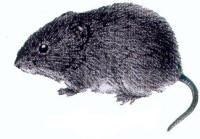 Voles are about the
size of a mouse and they have small, inconspicuous eyes
and very short tails. Like most rodents, they have a
pair of "buck teeth" coming from their top jaw. Their
fir is charcoal gray to brown on their backs but their
underside is generally of a lighter color. People have
noticed that they do not climb well and usually have
difficulty overcoming a barrier 6 inches or so in
height.
Voles are about the
size of a mouse and they have small, inconspicuous eyes
and very short tails. Like most rodents, they have a
pair of "buck teeth" coming from their top jaw. Their
fir is charcoal gray to brown on their backs but their
underside is generally of a lighter color. People have
noticed that they do not climb well and usually have
difficulty overcoming a barrier 6 inches or so in
height.
They travel around
in very shallow tunnels that sometimes collapse in on
themselves and more resemble a trench. Their diet
consists almost exclusively of vegetable matter and they
love to chew on the roots and crowns of
hosta plants.
Voles are not known to eat hosta leaves.
One of the
tell-tale signs of voles is the presence of
quarter-sized holes near the base of the hosta plant. If
they have been feeding on the roots and crown for a
while, the first symptoms you will see is that the
leaves will begin to wilt. No roots...no water. Of
course, if the critters consume enough of the crown, the
plant will be killed.
Fortunately, voles
are not common to all parts of hostadom but, if you find
them in your collection, there are several ways to
"manage" them. I say manage because many hosta gardens
in a woodlot setting and that is the natural home of
these creatures. Even if you get rid of every vole in
your garden, the odds are great that new ones will move
back in soon.
Like all the other
major pests of hostas, there is no single "magic bullet"
that will once and for all eliminate voles from your
garden...at least not without turning the place into a
sterile, radioactive wasteland. Here are a bunch of
things that people have used with varying degrees of
success: wire baskets around the hostas, planting hostas
in pots inside of pots in the ground, putting sharp
gravel in the planting hole, live traps, mouse traps
and...if all else fails, poison baits.
Mr PGC Note:
If you decide to resort to poison baits, do an internet
search to find designs for techniques to make sure that
only the voles eat the bait. There are specially
designed boxes, pvc pipes and other methods for
minimizing the impact on non-target species such as
birds.



